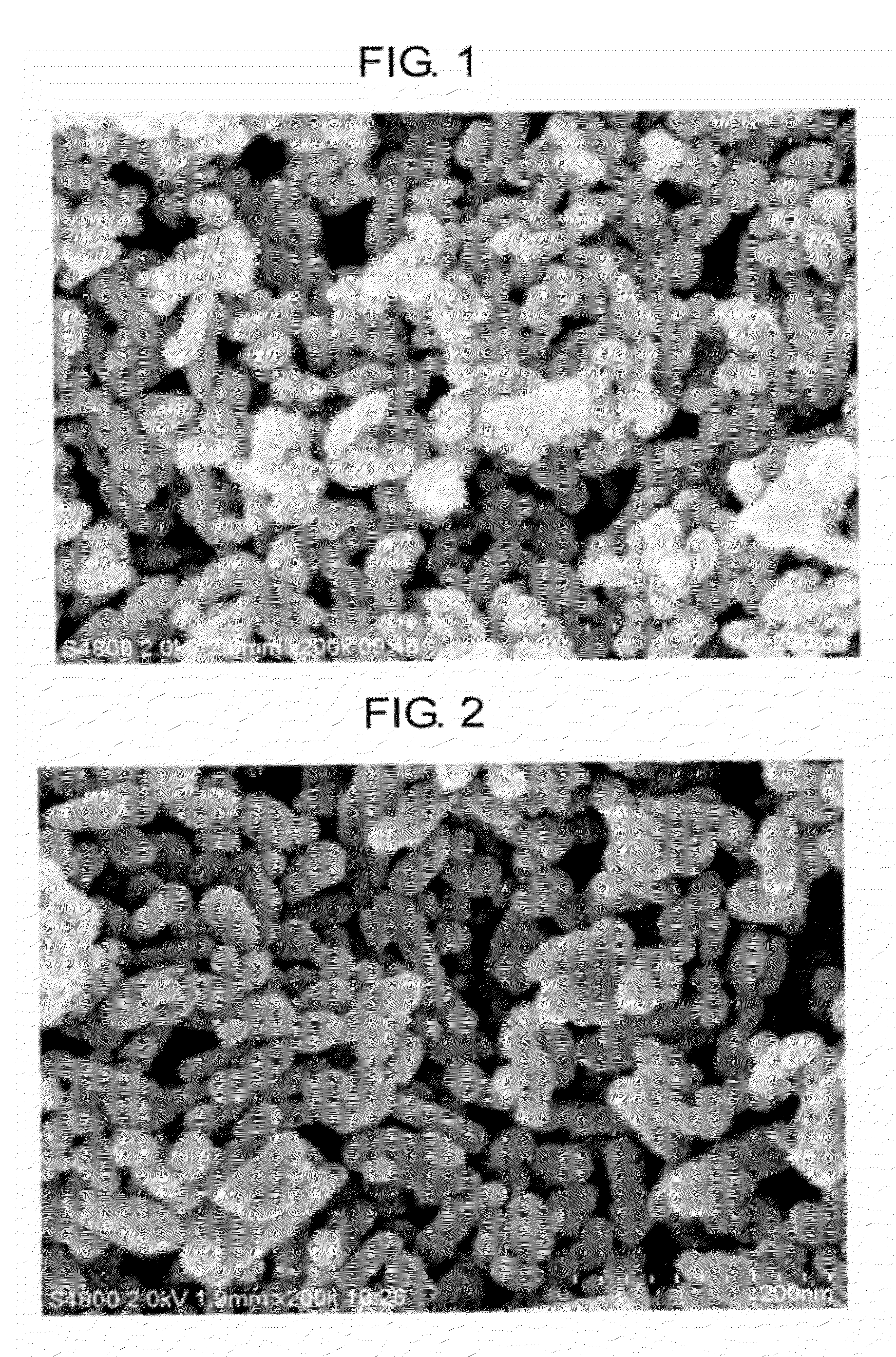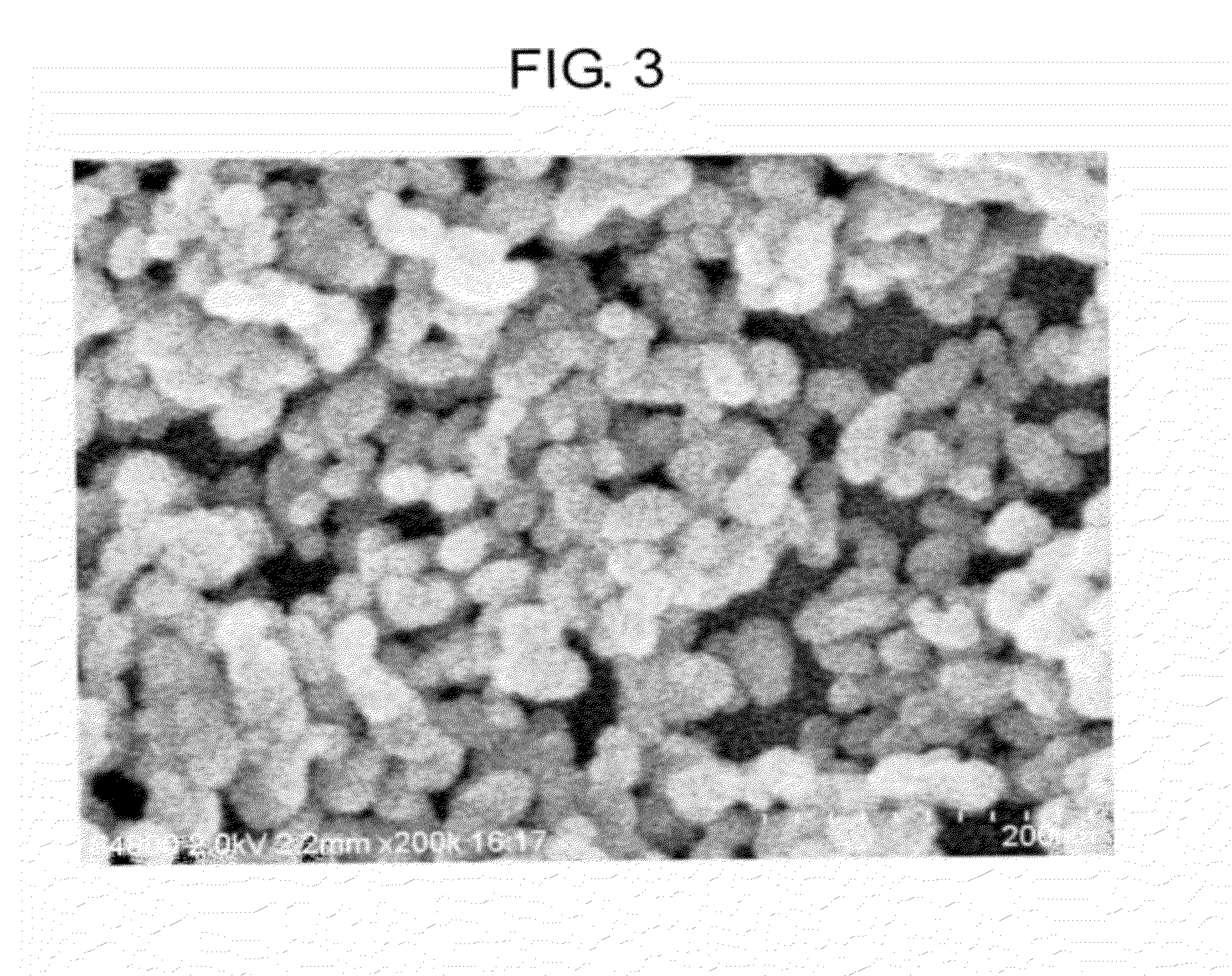Strontium carbonate micropowder and process for production
a technology of strontium carbonate and micropowder, which is applied in the field of fine strontium carbonate powder, can solve the problems of difficult preparation of powdery mixtures having uniform compositions and likely pulverized strontium carbonate particles, and achieve good dispersibility in liquid media
- Summary
- Abstract
- Description
- Claims
- Application Information
AI Technical Summary
Benefits of technology
Problems solved by technology
Method used
Image
Examples
example 1
[0045]In 3 L of pure water kept at 10° C. was placed and mixed 366 g of strontium hydroxide 8 hydrates to prepare an aqueous strontium hydroxide dispersion (concentration: 5.6 wt. %). To the aqueous strontium hydroxide dispersion was added 7.1 g (4.3 weight parts per 100 weight parts of strontium hydroxide) of tartaric acid (DL-tartaric acid, special class, available from Wako Junyaku Co., Ltd.). The resulting mixture was stirred to have tartaric acid solved. The aqueous strontium hydroxide dispersion was kept at 10° C. and gaseous carbon dioxide was introduced into the aqueous dispersion under stirring at a flow rate of 3.75 L / min. (i.e., 22 mL / min., per one gram of strontium hydroxide) until the aqueous dispersion showed pH 7, so as to produce strontium carbonate particles. The aqueous dispersion of strontium carbonate particles were further stirred for 30 minutes.
[0046]To thus produced aqueous dispersion of strontium carbonate particles was added 15 g (9.6 weight parts per 100 we...
example 2
[0050]A strontium carbonate powder was prepared in the same manner as in Example 1, except for replacing tartaric acid with malic acid (DL-malic acid, special class, available from Wako Junyaku Co., Ltd., 7.1 g).
[0051]The electron microscopic image of the resulting strontium carbonate powder is shown in FIG. 2. From the image of FIG. 2, it was confirmed that the resulting strontium carbonate powder was in the form of aggregated mass of spherical particles. The strontium carbonate powder was a fine powder showing a BET specific surface area of 83.4 m2 / g and a particle diameter (calculated from BET specific surface area) of 19.4 nm. A mean aspect ratio was 1.8.
[0052]Subsequently, a dispersion of strontium carbonate particles was prepared from the resulting strontium carbonate powder in the manner described in Example 1.
[0053]The average particle size of the strontium carbonate particles in the dispersion was determined by the dynamic light-scattering method. It was confirmed that the ...
example 3
[0054]A strontium carbonate powder was prepared in the same manner as in Example 1, except for replacing tartaris acid with gluconic acid (D-gluconic acid, special class, available from Wako Junyaku Co., Ltd., 25.5 g, namely, 15.2 weight parts per 100 weight parts of strontium hydroxide).
[0055]The electron microscopic image of the resulting strontium carbonate powder is shown in FIG. 3. From the image of FIG. 3, it was confirmed that the resulting strontium carbonate powder was in the form of aggregated mass of spherical particles. The strontium carbonate powder was a fine powder showing a BET specific surface area of 100 m2 / g and a particle diameter (calculated from BET specific surface area) of 16.2 nm. A mean aspect ratio was 1.3.
[0056]Subsequently, a dispersion of strontium carbonate particles was prepared from the resulting strontium carbonate powder in the manner described in Example 1.
[0057]The average particle size of the strontium carbonate particles in the dispersion was d...
PUM
| Property | Measurement | Unit |
|---|---|---|
| BET specific surface area | aaaaa | aaaaa |
| mean aspect ratio | aaaaa | aaaaa |
| flow rate | aaaaa | aaaaa |
Abstract
Description
Claims
Application Information
 Login to View More
Login to View More - R&D
- Intellectual Property
- Life Sciences
- Materials
- Tech Scout
- Unparalleled Data Quality
- Higher Quality Content
- 60% Fewer Hallucinations
Browse by: Latest US Patents, China's latest patents, Technical Efficacy Thesaurus, Application Domain, Technology Topic, Popular Technical Reports.
© 2025 PatSnap. All rights reserved.Legal|Privacy policy|Modern Slavery Act Transparency Statement|Sitemap|About US| Contact US: help@patsnap.com


